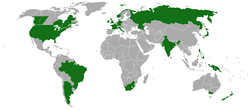Panaeolus cinctulus
Species of fungus From Wikipedia, the free encyclopedia
Panaeolus cinctulus, syn. Panaeolus subbalteatus, commonly known as the banded mottlegill, weed Panaeolus, belted panaeolus,[3] or subbs is a very common, widely distributed psilocybin mushroom. According to American mycologist David Arora, P. cinctulus is the most common psilocybin mushroom in California.
| Panaeolus cinctulus | |
|---|---|
 | |
| Scientific classification | |
| Domain: | Eukaryota |
| Kingdom: | Fungi |
| Division: | Basidiomycota |
| Class: | Agaricomycetes |
| Order: | Agaricales |
| Family: | Bolbitiaceae |
| Genus: | Panaeolus |
| Species: | P. cinctulus |
| Binomial name | |
| Panaeolus cinctulus | |
 | |
| Approximate Panaeolus cinctulus range | |
| Synonyms[1][2] | |
|
Agaricus cinctulus Bolton (1791) | |
| Panaeolus cinctulus | |
|---|---|
| Gills on hymenium | |
| Cap is campanulate or convex | |
| Hymenium is adnate or adnexed | |
| Stipe is bare | |
| Spore print is black | |
| Ecology is saprotrophic | |
| Edibility is psychoactive | |
Etymology
The descriptor subbalteatus comes from the Latin words sub ('somewhat') and balteat ('girdled'), a reference to the dark outer band of the cap.[4]
Description
Summarize
Perspective
- Cap: 1.5–5.5 centimetres (5⁄8–2+1⁄8 in), hemispherical to convex when young to broadly umbonate or plane in age,[4] smooth, hygrophanous, striking cinnamon-brown when moist, soot-black when wet which disappears as the mushroom completely dries out. The outer band is usually darker.[4] The flesh is cinnamon-brown to cream-colored and thin.
- Gills: Close, adnate to adnexed, cream-colored when young, later mottled dingy brown then to soot-black. Gill edges white and slightly fringed, but turn blackish when fully mature.[5]
- Spore print: Black[6]
- Stipe: 2–10 cm long, 2–9 mm thick, equal or tapered at the ends, reddish brown to whitish, pruinose, hollow, no veil remnants, longitudinally white-fibrillose and white-powdered, striate at the apex or twisting vertically down the entire length of the stipe, Stem base and mycelium occasionally staining blue.
- Taste: Farinaceous (like flour) when fresh, saliferous (salty) when dried.
- Odor: Slightly farinaceous.
- Microscopic features: Spores 11–16 x 7.5–10 x 6–9 μm, smooth, elliptical to rhomboid in face view, thick-walled, elliptical in side view.
Similar species
Morphologically, Panaeolus cinctulus can be easily confused with other species of psilocybin mushrooms. They have a resemblance to Panaeolus fimicola, and prefer the same habitats, but the latter species has sulphidia on the gill faces.
It can also resemble P. fimicola, P. foenisecii, and P. olivaceus.[6]
Habitat and formation
Panaeolus cinctulus is a cosmopolitan species that grows solitary to gregarious to cespitose (densely clumped) on compost piles, well-fertilized lawns and gardens, and, rarely, directly on horse dung.[7] It grows from spring to fall, abundantly after rain. It can be found in many regions, including: Africa[8] (South Africa),[8] Austria,[8][9] Canada (Alberta, British Columbia, New Brunswick, Prince Edward Island, Ontario, Quebec, Nova Scotia[8]), Denmark,[9] Finland,[10] France,[8] Germany,[8][9] Great Britain,[8] Guadeloupe,[9] Estonia,[8] Iceland,[8] India,[8] Ireland,[8] Italy,[8] South Korea,[8] Japan,[8] Mexico,[10] New Guinea,[8] New Zealand,[8] Norway,[9] Philippines,[8] Russia,[8] Slovenia,[9] South America (Argentina, Chile, Brazil)[8] and the United States (common in Oregon, Alaska, Washington, and both northern and southern California, but known to occur in all 50 states).[citation needed]
It has also been sighted in Melbourne, Australia, Central Queensland, Australia Belgium and the Czech Republic.[citation needed]
Legality
The legal status of psilocybin mushrooms varies worldwide. Psilocybin and psilocin are listed as Class A (United Kingdom) or Schedule I (US) drugs under the United Nations 1971 Convention on Psychotropic Substances.[11] The possession and use of psilocybin mushrooms, including P. cinctulus, is therefore prohibited by extension. However, in many national, state, and provincial drug laws, there is a great deal of ambiguity about the legal status of psilocybin mushrooms and the spores of these mushrooms. Panaeolus cinctulus is mildly psychoactive.[4]
In culture
During the early 1900s, these species were referred to as the "weed Panaeolus" because they were commonly found in beds of the commercially grown, grocery-store mushroom Agaricus bisporus. Mushroom farmers had to weed it out from the edible mushrooms because of its hallucinogenic properties.[12]
Gallery
|
See also
References
External links
Wikiwand - on
Seamless Wikipedia browsing. On steroids.










